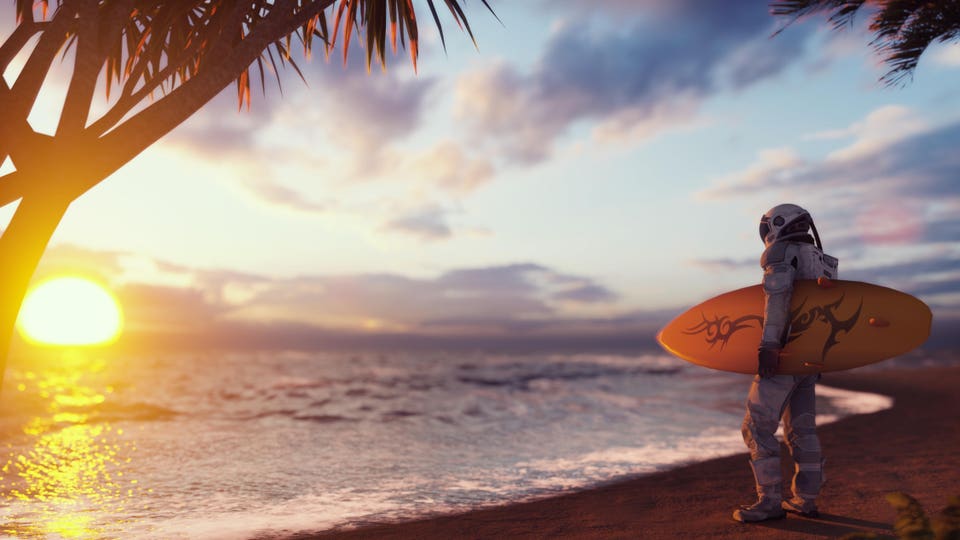Forbes Innovation Science Astronaut’s Brains Need Three Years Off Between Trips, Say Scientists Jamie Carter Senior Contributor Opinions expressed by Forbes Contributors are their own. I inspire people to go stargazing, watch the Moon, enjoy the night sky Following Jun 8, 2023, 07:15pm EDT | Press play to listen to this article! Got it! Share to Facebook Share to Twitter Share to Linkedin A study shows it takes about three years between flights for the ventricles in the brain of an . .
. [+] astronaut to fully recover after a mission. getty Amid a lot of talk about crewed missions to the moon and the coming era of much longer crewed missions to Mars and beyond there’s one thing that doesn’t get discussed enough—and that’s gravity.
More specifically, the importance of gravity to humans and the need to develop spacecraft with artificial gravity . That’s underscored today by the publication in the journal Scientific Reports today of a new study of 30 astronauts that reveals long spaceflights take such a toll on the human brain that a three-year break between missions should be considered by space agencies. The study found physiological changes in the brains of astronauts that were at their most dramatic among those who stayed in space the longest—though changes may plateau after six months.
Do we need spacecraft with artificial gravity before longer spaceflight missions can be considered? getty How spaceflight changes the human brain The absence of gravity expands cavities in the brain called ventricles, which provides protection, nourishment and waste removal to the brain. The longer you stay in space, the more they expand. For astronauts in space for longer than six months it may take three years for the ventricles to shrink back to normal size, says the report.
“We found that the more time people spent in space, the larger their ventricles became,” said Rachael Seidler, a professor of applied physiology and kinesiology at the University of Florida and an author of the study. “Many astronauts travel to space more than one time, and our study shows it takes about three years between flights for the ventricles to fully recover. ” MORE FOR YOU NASA Probe Flew So Close To The Sun It Saw Solar Wind Being Born Supernova Dazzles In Jaw Dropping New Image From A Massive Telescope Future Of Cruising Norway s Hurtigruten Unveils Radical Zero Emission Ship Design Ventricular expansion is the most enduring change seen in the brain as a result of spaceflight.
The problem, of course, is the absence of gravity. It causes fluid to shift upward, pushing the brain higher within the skull and causing the ventricles to expand. A Blue Origin New Shepard rocket launches from Launch Site One in West Texas north of Van Horn on .
. . [+] March 31, 2022.
The NS-20 mission carries Blue Origins New Shepard Chief Architect Gary Lai, Marty Allen, Sharon Hagle, Marc Hagle, Jim Kitchen, and Dr. George Nield into space. (Photo by Patrick T.
FALLON / AFP) (Photo by PATRICK T. FALLON/AFP via Getty Images) AFP via Getty Images Space tourism declared safe Space tourists need not worry since short trips appear to cause little physiological changes to the brain. “The biggest jump comes when you go from two weeks to six months in space,” said Seidler.
“There is no measurable change in the ventricles’ volume after only two weeks. ” Some other good news is that there appears to be little further change to the size of ventricles after six months. “We were happy to see that the changes don’t increase exponentially, considering we will eventually have people in space for longer periods,” said Seidler.
In theory that may mean trips to Mars—most of which would take 800 to 1,000 days to complete—would be no more damaging than spending six months in space. But there’s a problem. NASA astronaut Mark Vande Hei completed a single mission aboard the International Space Station of .
. . [+] 355 days on March 30, 2021.
NASA astronaut Scott Kelly’s final mission aboard the orbiting lab ended after 340 days on March 1, 2016. NASA Recovery position Data came from 30 astronauts: Eight traveled to space for two weeks. 10 traveled to space for six-months.
Four traveled to space for just under a year. In seven astronauts who had less than three years between missions the size of their ventricles appeared not to shrink back to their normal size, suggesting a three-year break is needed. NASA astronaut Mark Vande Hei returned from 168 days in space on February 28, 2018 only to launch once again on April 9, 2021—just over three years later—on a 355 day mission.
There are three other NASA astronauts who have spent more than 300 days in space in recent years. Although the study’s authors reported that ventricular enlargement tapered off after six months, beyond a year in space there is no data. “We don’t yet know for sure what the long-term consequences of this is on the health and behavioral health of space travelers,” said Seidler, “so allowing the brain time to recover seems like a good idea.
” It makes the once-in-15-years opportunity in 2033 to send a relatively short 570 days mission on a flyby of Mars and Venus seems like a necessary step in sending humans on long space flights. Wishing you clear skies and wide eyes. Follow me on Twitter or LinkedIn .
Check out my website or some of my other work here . Jamie Carter Editorial Standards Print Reprints & Permissions.
From: forbes
URL: https://www.forbes.com/sites/jamiecartereurope/2023/06/08/astronauts-brains-need-three-years-off-between-trips-say-scientists/
